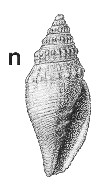
Revised descriptions of New Zealand Cenozoic Mollusca from Beu and Maxwell (1990)

 | Revised descriptions of New Zealand Cenozoic Mollusca from Beu and Maxwell (1990) | 
|
  (Pl. 21n): GS9500, J41/f8028, excavation for Oamaru Borough Council septic tank, South Oamaru, Altonian (GNS) |
Beu & Maxwell (1990): Chapter 11; p. 203; pl. 21 n.
Synonymy: Mitra apicalis Hutton 1873b, p. 7; Vexillum apicale; Proximitra tumens Finlay 1930b, p. 62
Classification: Volutomitridae
Description: Size moderate for genus (height 9-17 mm), biconic to fusiform, spire 0.37-0.5 total height. Protoconch mamillate, of 1.5 whorls, smooth except for feeble spiral grooves and axial costellae near end. Teleoconch of 4-5.5 whorls, a subsutural concavity developing at a very early stage, gradually producing a well defined shoulder; angulation at or slightly above middle on spire whorls of some shells, but much lower down on others, sutural ramp flat to gently concave. Last whorl broadly and shallowly excavated, neck not well differentiated. Axial sculpture on earliest part of teleoconch of narrow, low costellae reaching from suture to suture, but soon becoming obsolete on ramp, and on later whorls, restricted to low, rounded peripheral tubercles with little or no axial prolongation, typically becoming less distinct on last whorl, and in some shells obsolete near outer lip; 14-24 tubercles on penultimate whorl. Spiral sculpture subdued, of very low, rounded or flattened cords with linear interspaces. Aperture similar to that of P. rutidoloma (see above), anterior plait much weaker than others and close to the one above.
Comparison: Finlay (1930b, p. 62) claimed that Proximitra tumens could be distinguished from P. apicalis by its more inflated shell, its lower spire (and hence greater spire angle) and its more numerous shoulder nodules (17-21 as against 14-15), although both he and Cernohorsky (1970a, p. 134) conceded that it might only be an extreme morphotype of P. apicalis. Examination of a series of shells from the localities listed, however, shows that there is no consistent correlation between number of tubercles per whorl and either relative spire height or relative width, although — as might be expected — most of the slender shells have fewer nodules than on the broad shells. P. tumens was, therefore, synonymised with P. apicalis by Beu & Maxwell (1990). Cernohorsky (1970a, p. 133) synonymised P. partinoda (Otaian, Bluecliffs and Pareora River) with P. apicalis, but P. partinoda is considerably smaller than P. apicalis (height 9-10 mm) and consistently has the shoulder tubercles obsolete over much or all of the last whorl of adult shells, and it is clearly a distinct species. P. enysi (Duntroonian, widespread) differs from P. apicalis in having much coarser axial sculpture, in the nature of distinct costae rather than nodules.
Distribution: Altonian; Mount Harris Formation, Awamoa, Oamaru (type locality of M. apicalis); Pukeuri road cutting, Oamaru (type locality of P. tumens); Old Rifle Butts, Cape Wanbrow; All Day Bay; excavation for Oamaru Borough Council septic tank, south Oamaru. Moderately common at all localities.
Cite this publication as: "A.G. Beu and J.I. Raine (2009). Revised
descriptions of New Zealand Cenozoic Mollusca from Beu and Maxwell (1990). GNS
Science miscellaneous series no. 27."
© GNS Science, 2009
ISBN
978-0-478-19705-1
ISSN 1177-2441
(Included with a PDF facsimile file
copy of New Zealand Geological Survey Paleontological Bulletin 58 in CD version
from: Publications Officer, GNS Science, P.O. Box 30368 Lower Hutt, New
Zealand)